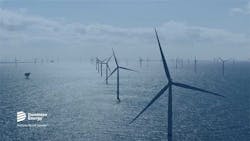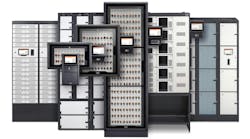Building a Greener Cloud: Tech Titans Pledge More Renewables for Data Centers
“Sustainable digital infrastructure.” That phrase, highlighted by Google CEO Sundar Pichai, is the clear theme in a series of announcements this week from some of the most important players in creating a future in which cloud computing is powered by renewable energy.
The announcements from Google, Amazon and Dominion Energy are all notable in their own right. Taken together, they reinforce the crucial role played by large data center operators in shifting business activity to a sustainable model. Importantly, they also suggest progress on one of the industry’s toughest challenges – securing green power to support data center growth in Virginia.
On a day of global climate action, these huge technology firms are investing enormous resources in shifting their operations to renewable power, with large purchases
Here’s a look at this week’s news:
- Google announced 18 new renewable energy deals, adding a combined 1.6 gigawatts of solar and wind energy, which the company said was the largest corporate purchase of renewable energy in history. That continues a pattern of leadership in which Google has matched its electricity consumption with renewable energy purchases in both 2017 and 2018. Most of that energy goes to support Google’s massive network of data centers, which power everything from YouTube videos to Gmail to every query you type into the search field.
- Amazon has committed to meet the terms of the Paris Agreement 10 years early, reaching net carbon zero operations by 2040. The pledge includes a commitment to boost its user of renewable energy to support 80 percent of its for its operations by 2024 and 100 percent by 2030. While Amazon did not provide details, those goals cannot be met without an acceleration of renewable energy purchases to support Amazon Web Services, the company’s massive cloud computing platform. Amazon’s pledge also indicates a commitment to address the carbon footprint of its operations in Northern Virginia, where it maintains more than 50 data centers and is building more. A recent Greenpeace report singled out Amazon Web Services, saying its adoption of green power is falling behind the growth of its cloud infrastructure, especially in Virginia.
- Dominion Energy, which has been under pressure to boost the availability of renewable energy for Northern Virginia’s fast-growing data center business, announced plans for an offshore wind generation facility that will bring 2.6 gigawatts of wind power online between 2024 and 2026. The project, which will feature 220 giant wind turbines 27 miles off the coast near Virginia Beach, is an expansion of a pilot project that is nearing production. The announcement follows criticism from Greenpeace of Dominion’s adoption of renewable power, even as its largest data center customers press the utility for more green electricity to support their growth in Northern Virginia.
Cloud computing has emerged as a surprising force in the shift to renewable energy to power the Internet economy, with Google, Facebook, Amazon, Microsoft and Apple making public commitments to sourcing renewable energy for their cloud data centers. These companies have used power purchase agreements (PPAs) to buy wind and solar energy to offset their data center energy use.
“Beyond our own operations, we’re working to make clean energy mainstream and break down the barriers for those who want to purchase renewable energy,” said Pichai.
Google Going Big
With this week’s purchase, Google’s worldwide portfolio of wind and solar agreements has reached 5.5 gigawatts – that’s 5,500 million watts of electricity, the equivalent of the capacity of a million solar rooftops. “Once all these projects come online, our carbon-free energy portfolio will produce more electricity than places like Washington D.C. or entire countries like Lithuania or Uruguay use each year,” Google said.
The latest agreements will spur the construction of more than $2 billion in new energy infrastructure, including millions of solar panels and hundreds of wind turbines spread across three continents. That includes 720 MW from solar farms in North Carolina (155 MW), South Carolina (75 MW), and Texas (490 MW).
The search giant said it is increasingly focusing on opportunities in solar generation. “Up to now, most of our renewable energy purchases in the U.S. have been wind-driven, but the declining cost of solar (down more than 80 percent in the past decade) has made harnessing the sun increasingly cost-effective,” Pichai wrote on the Google blog.
Nearly half of the new renewable capacity will be in Europe, where Google is backing 10 renewable energy projects. “These agreements will spur the construction of more than 1 billion euros in new energy infrastructure in the EU, ranging from a new offshore wind project in Belgium, to five solar energy projects in Denmark, and two wind energy projects in Sweden,” Pichai wrote. “In Finland, we are committing to two new wind energy projects that will more than double our renewable energy capacity in the country, and ensure we continue to match almost all of the electricity consumption at our Finnish data center with local carbon-free sources, even as we grow our operations.”
Google data center executive Joe Kava recently said the company is seeking to match its data center operations with renewable energy, on an hour-by-hour basis in every location.
A Greener AWS is Coming
Amazon’s renewable energy projects are expected to generate 2.9 gigawatt hours of renewable energy each year. The company says it has offset about 50 percent of the operations of Amazon Web Services as of the end of 2018.
Nonetheless, in February Amazon came under fire from Greenpeace, which said although AWS has added an estimated 600 megawatts of data center capacity in Virginia over the past two years, it has not added any new renewable energy supply, leading Greenpeace to argue that AWS no longer appears to be honoring its commitment to 100 percent renewables.
Amazon vigorously disputed Greenpeace’s conclusions and data, and the group’s suggestion that it had slowed its pace of energy purchases. Since the report, Amazon has announced renewable energy purchases totaling an additional 300 megawatts of energy, including a solar farm that will add 45 megawatts in Virginia.
This week’s Climate Pledge announcement did not provide a detailed roadmap on Amazon’s plans to offset the AWS carbon footprint, but the only way to achieve its goals would be to step up its acquisition of renewable energy to address the power used by AWS data centers in Northern Virginia.
“We’re done being in the middle of the herd on this issue—we’ve decided to use our size and scale to make a difference,” said Jeff Bezos, Amazon founder and CEO. “If a company with as much physical infrastructure as Amazon—which delivers more than 10 billion items a year—can meet the Paris Agreement 10 years early, then any company can.”
The pressure on Amazon is not only external. A group called Amazon Employees for Climate Justice has called for the company to commit to zero carbon emissions by 2030, 10 years sooner than the goal the company unveiled this week. About 1,500 Amazon employees are expected to participate in today’s student-led global climate strike.
Amazon has also created a Sustainability web site to document its progress.
Dominion Goes Offshore
Dominion’s wind power announcement came just days after Gov. Ralph Northam issued an executive order calling on state agencies to develop a plan for Virginia to produce 30 percent of its electricity from renewable sources by 2030 and to be fully carbon-free by 2050.
“Offshore wind is an excellent renewable energy source and this filing with PJM shows how serious we are about bringing commercial-scale offshore wind to Virginia, giving our customers what they have asked for – more renewable energy,” said Mark D. Mitchell, vice president of generation construction at Dominion, in a news release. “Governor Ralph Northam has made it clear Virginia is committed to leading the way in offshore wind. We are rising to this challenge with this 2,600-megawatt commercial offshore wind development.”
If approved, the project would be located in the 112,800 acres Dominion Energy currently is leasing from the Bureau of Ocean Energy Management 27 miles off the coast of Virginia Beach. Following the key filing with PJM, ocean survey work is expected to begin in 2020 and a Construction and Operations Plan will be submitted in 2022. Dominion Energy plans to move forward with its commercial offshore wind project in three phases, each totaling 880 megawatts.
Northern Virginia accounted for 55 percent of all new data center space in 2018, with more than 270 megawatts of capacity leased. Meanwhile, Dominion Energy sources just 5 percent of its electricity from renewable sources, with most of its energy coming from nuclear power (33.8%), natural gas (33.6%) and coal (26.5%).
Greenpeace says Dominion’s renewable generation trails demand, serving as a major barrier to creating a “clean cloud” supported by renewable energy. Dominion said it is working to balance its energy mix. but the process takes time.
“A vast number of the world’s data centers reside in our service area, and it is our responsibility to not only provide them with reliable energy, but to help them meet their renewable energy goals,” said Keith Windle, vice president of Business Development for Dominion. “Our strategy for the future is on balancing our portfolio to meet our customers’ future energy needs in the most reliable, affordable and environmentally sustainable manner possible.”
About the Author




